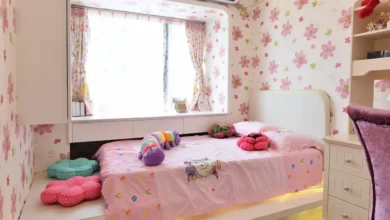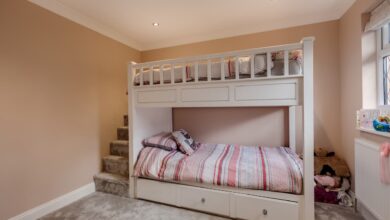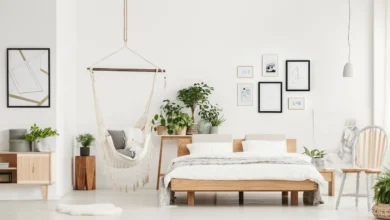Designing the Perfect Preschooler Bedroom
Create a Fun and Functional Bedroom Space for Your Children
Decorating your child’s room can be exciting and challenging. It’s the place where your child will sleep, play, and grow. It’s important to design a space that not only reflects the personality of your child but also offers a safe and comfortable environment. Designing the perfect preschooler bedroom requires attention to detail and thoughtful planning. It’s crucial to strike the perfect balance between practicality and creativity, whether you are starting from scratch or updating an existing space. This comprehensive guide will show you how to create a space for your child that is both functional and fun.
1. Include your child in the design process
Involving your child in the process of designing their bedroom is the first step. Children have strong opinions and preferences about the way they want to decorate their bebedroomsParticipating in the design process will help them feel like they are part of it and make a space that they love. Ask them about their favourite colours, hobbies and dream designs. Let your child choose their bedding, wall colours, or decorative pieces if they are old enough. Offer a few options that are in line with your vision for younger children. This collaborative approach will ensure that the result is a personal sanctuary.
You can create great bonding moments by engaging in the creative process with your partner. You can discuss what they imagine, find out new interests with them, and make sure that they feel a part of your creative journey. Their enthusiasm and excitement will enhance the entire experience when you include them in the conversation.
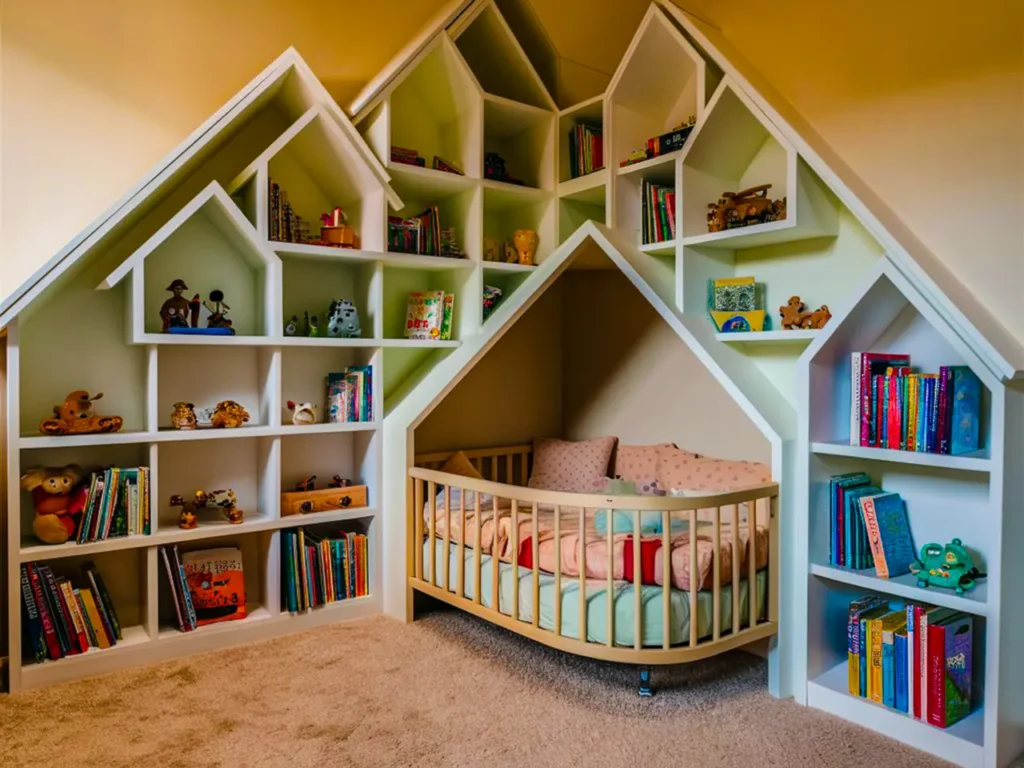
2. Get Creative With DIY Projects
DIY projects can be a great way to customize your child’s room. There are many ways to personalize the room, whether it is by creating custom artwork, painting picture frames or DIY storage solutions. Involving your children in the creation of these items will foster creativity and provide lasting memories.
You can create a piece of personalized decor by painting a mural, creating a custom pillow cover or repurposing furniture. DIY crafts are a wonderful way to update your child’s room as they grow and adapt to their changing tastes. You can update the colour scheme or swap out the decorations as they move from one stage to the next. This will keep the room looking fresh and reflecting their changing style.
You can also let them decorate the room with their artwork or decorations. It’s a great way to let them express themselves and make their room more personal.
3. Select a Color Scheme and Theme
The choice of a colour scheme and the theme is essential when designing a child’s room. It’s important to consider how your child will grow and change as you choose a theme. Your toddler might love a princess theme, but by the time your child is a preteen, they may prefer a more sophisticated style. It’s important to choose a theme that can be easily adapted. Think about themes like nature, outer space, adventure or abstract designs. These can be relevant for years.
Choose colours that are complementary to the theme of the room and create the mood you desire. Pastel colours create a calming atmosphere, while vibrant shades can add energy and excitement. Mixing colours can give a room visual depth and interest. Light blues, yellows or pinks create a calm, soothing space for younger children. Older children will enjoy vibrant colours such as navy, crimson or metallic accents.
A practical tip would be to use a neutral colour as the foundation of your room, such as white, light grey, or beige so that it can grow along with your child. You can then easily update the room by adding new wall art, pillows, rugs and other accessories that match their interests.
4. Brighten up the room with the right lighting
Lighting is an important part of any room’s design and plays a major role in the bedroom of a child. The right lighting will not only improve the ambience of a room but will also make it more functional for different activities such as reading or playing. Mixing different lighting sources can help you create the mood and task lighting that is needed.
Consider adding wall sconces, table lamps, and floor lamps to the room to create a softer ambient light. A reading lamp can encourage your child to read before bed. Dimmable lighting is also recommended to allow the room to easily transition between bright daylight and calmer nighttime illumination.
Lighting fixtures can be incorporated into the theme of a room. A fun, quirky lamp can serve as both a decorative and functional piece. A moon-shaped lamp would be perfect for a room with a space theme, and whimsical starlights could work well in a fantasy or magical-themed room.
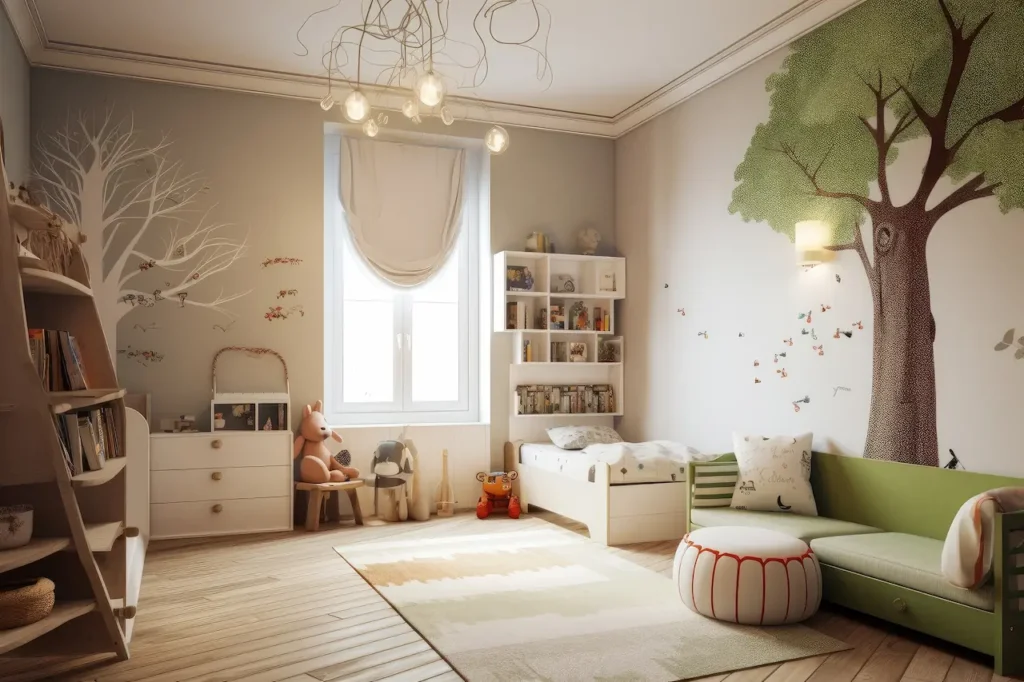
5. Create a Cozy Reading Nook
A cozy reading corner in your child’s room is a wonderful way to promote a love of books. Add soft lighting, comfortable seats, and shelves with their favourite books to make this area inviting and relaxing. Create a special area with a beanbag or comfy chair, a rug, decorative pillows, and perhaps even a curtain or canopy to create the feeling of a private retreat.
A reading nook doesn’t need to be huge. It can be a quiet, small corner that provides a place for reflection, relaxation and creativity. Rotate the books in the nook to introduce new stories and keep it engaging. Add some fun elements to the space, such as an ebook-themed lamp or a throw blanket.
6. Make Space for Play
The bedroom of a child is more than a place to sleep. It should be able to accommodate play and exploration. Allowing enough space on the floor for toys, games, and activities will encourage imagination. If your child enjoys building with blocks, role-playing, or creating art, you can dedicate a space to these activities.
Open-ended play areas encourage creativity and allow your child to relax, learn and grow. Toys and games can be kept easily accessible with a toy chest or shelving unit. Choose pieces that will complement the design of the space while allowing for easy organization.
7. Use Smart and Stylish Storage Solutions
It is important to have storage in a child’s bedroom as toys, clothes, books, and other items accumulate. Smart and stylish storage will keep the room organized while also adding to its overall design.
Look beyond the basic bins. Find creative and attractive ways to store the things of your child. Storage boxes, baskets and stylish bins can serve as a functional solution while also blending in with the decor of a room. Furniture that can be used as both storage and a functional piece of furniture, such as a toy box a bed with built-in drawers or shelves, is a great way to save space.
Make sure the storage is accessible to younger children. Allow older children to organise their space using modular systems or study and shelving areas.
8. Create a Cozy and Comfortable Atmosphere
When designing your child’s room, comfort should be the top priority. This room should be a place where your child can rest, feel safe, and relax. Invest in bedding of high quality that meets their comfort level, whether it is soft, breathable fabric or warm, cozy quilts. Add plush pillows, a throw blanket and other comforting items to the bed.
A crib or toddler’s bed with a comfortable, supportive mattress is vital for toddlers to get a good night’s sleep. Consider upgrading your child’s bed to a full size with a mattress that provides good support.
Add elements to make the space feel warm and inviting, like a soft rug for children to play on or a hammock chair to read in.
9. Design according to your child’s age and interests
As your child’s tastes and needs change, so do their needs. A toddler’s space will need a different approach to design than a teenage bedroom. It’s important to consider safety measures for younger children. This includes furniture with rounded corners, childproofing, and secure furniture. As your child grows, you can introduce furniture and decor more suitable to their age and interest.
As your child grows, involve them in the process. Allow them to make design decisions, including collections and furniture, so that they feel the room reflects the unique personality of the child.
10. Plan for the Future
To design a child’s bedroom, you need to be foresighted. Children grow quickly, and their tastes also change rapidly. Choose neutral colours and furniture that can be easily adapted to the theme of the room instead of a theme that may fade over time. You can easily update the room with new artwork, decor and accessories to suit your changing tastes.
Choose furniture that will grow and change with your child, like a convertible crib. This thoughtful approach can help you create a space that will remain relevant for many years.
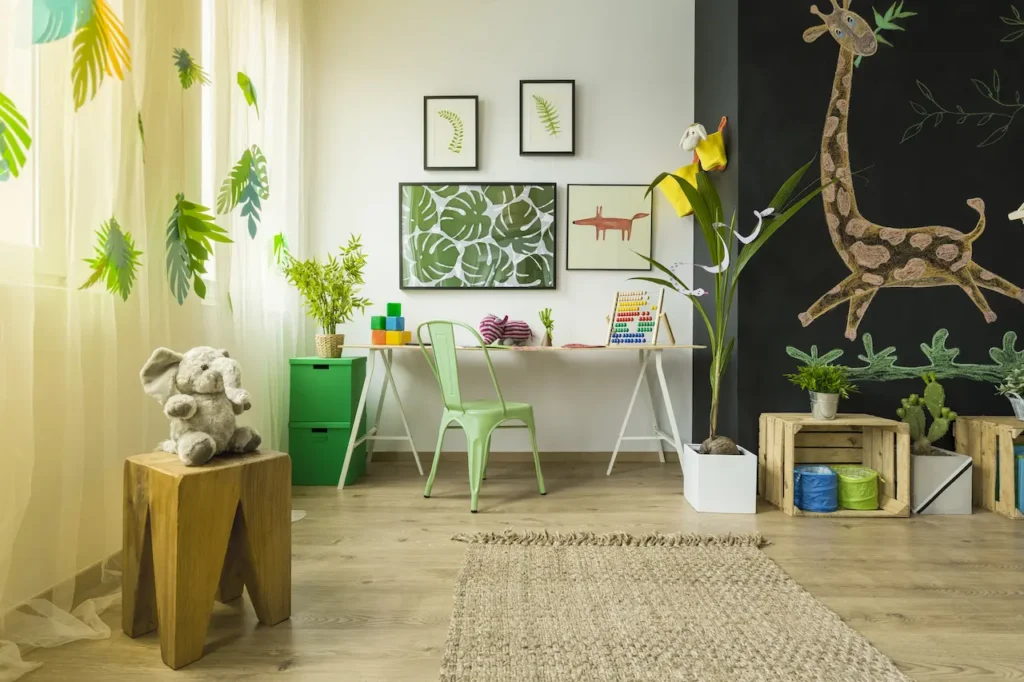
Create a Playful and Safe Space
Safety is the most important factor when designing a room for toddlers. Toddlers need a space that is safe for them to explore and play. Make sure the room is childproofed. Secure heavy furniture to walls, install safety gates and avoid sharp corners or choking hazards. Furniture that is low and accessible will enable them to use the room independently. For extra safety, use rugs that have non-slip backing. Also, cover electrical outlets.
Add a table and chairs set that is small but playful for children to use when they are doing activities such as drawing or building things with blocks. Soft cushions and a tent-like structure can be used to create a cozy corner where children can retreat.
Bedroom ideas for older children
As your child grows, the bedroom will become a personal space reflecting their personality. Teenagers may prefer a bedroom that reflects their interests, hobbies and personality. Give them the freedom to select furniture, colours and accessories that match their style.
Children need functional areas for study and relaxation. Think about incorporating shelving units, desks or comfortable seating to help with studying, creative pursuits or time spent with friends.
Conclusion
It’s not just about decorating a child’s room. You want to create a space that encourages your child’s creativity and individuality. Following these tips will help you create a stylish and functional room. It doesn’t matter if it is a space that will grow with your child or a place to relax for teens. The key is creating a space that can meet their changing needs. Your child’s bedroom can be transformed into a place of joy and comfort with a little creativity, thoughtful design and their help.

